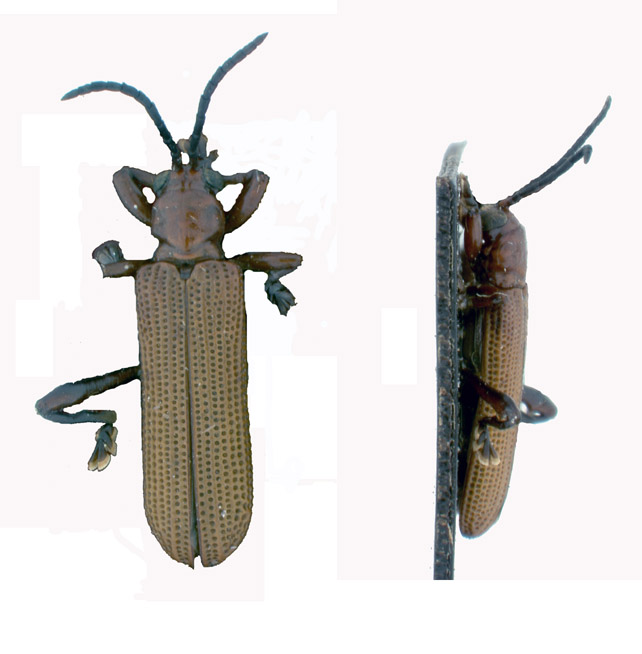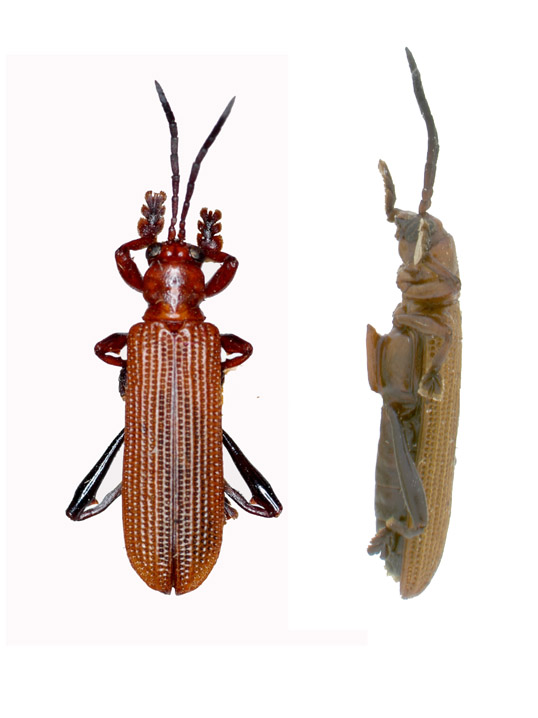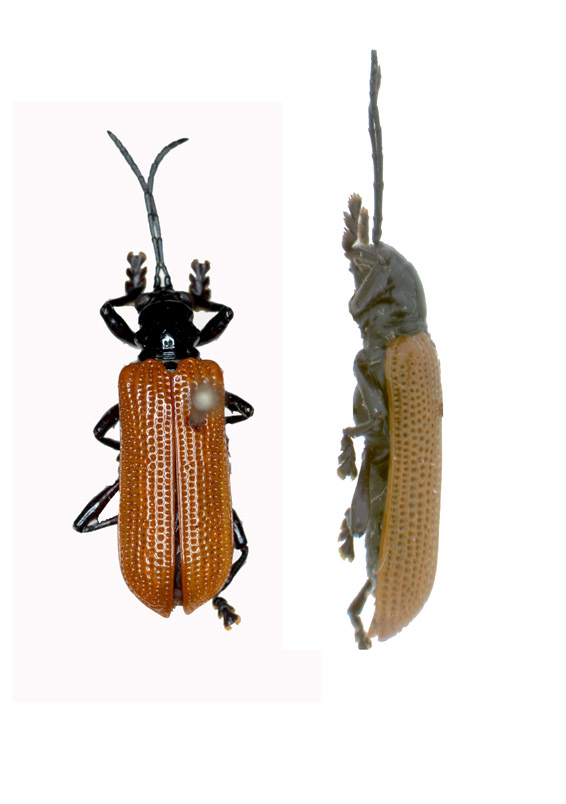Promecotheca
|
Promecotheca opacicollis |
|
Promecotheca nuciferae |
|
Promecotheca cumingii |
|
Promecotheca callosa |
|
Promecotheca caeruleipennis |
Introduction
Promecotheca Blanchard (Coleoptera: Chrysomelidae: Cassidinae) contains 33 species from the Pacific Region (Staines 2012) and is in need of revision. Eight species have been reported as serious palm pests. Life history studies have been conducted on Promecotheca caeruleipennis Blanchard (Taylor 1937), Promecotheca cumingii Baly (Lever 1951), Promecotheca opacicollis Gestro (Lever 1933, Risbec 1937), and Promecotheca papuana Csiki (Froggatt 1939, O’Connor 1940; Gressitt 1959). The Damage and Life History Notes sections contain a general summary of the published information on these four species.
Distribution
Promecotheca caeruleipennis is found in Fiji, Philippines, Samoa, Solomon Islands, and Tonga.
Promecotheca callosa Baly is found in Australia (Queensland) and New Guinea.
Promecotheca cumingii is found in China, Indonesia (Borneo, Celebes, Java), Malaysia, Philippines (Leyte, Luzon, Mindanao, Palawan, Samar), Singapore, and Sri Lanka.
Promecotheca nuciferae Maulik is found in Indonesia (Celebes, Java, Moluccas).
Promecotheca opacicollis is found in New Hebrides.
Promecotheca papuana is found in Solomon Islands (Bougainville, New Britain) and New Guinea.
Promecotheca similis Uhmann is found in Philippines (Luzon).
Promecotheca soror Maulik is found in Indonesia (Celebes, Moluccas).
Promecotheca varipes Baly is found in Australia (Northern Territory) and New Guinea.
Hosts
Promecotheca caeruleipennis feeds on Cocos nucifera L. (Froggatt 1914); Pritchardia pacifica Seem. et Wendl., and Livistona sp. (Taylor 1937) (Arecaceae).
Promecotheca callosa feeds on palms (Froggatt 1914); Cocos nucifera L. (Lepesme 1947) (Arecaceae) and Pandanus sp. (Pandanaceae) (Gressitt 1963).
Promecotheca cumingii feeds on Cocos nucifera L. (Schultze 1916); Nipa sp., Metroxylon sp. (Kalshoven 1951); Caryola sp. (Lepesme 1947); and Oreodoxa regia Kth. (Zaka-Ur-Rab 1991) (Arecaceae).
Promecotheca nuciferae feeds on Cocos nucifera L. (Maulik 1929); Areca catechu L., Phytelephas macrocarpa Ruiz. & Pav., and Phoenix sp. (Speyer 1954) (Arecaceae).
Promecotheca opacicollis feeds on Cocos nucifera L. (Maulik 1919); Areca catechu L., Phoenix sp., Phytelephas macrocarpa Ruiz. et Pav., and Ravenala madagascariensis Gmel. (Lepesme 1947) (Arecaceae).
Promecotheca papuana feeds on Cocos nucifera L., Areca cathecu L., Nipa fruticans Thunb., Metroxylon sagu Rottb., and Elaeis guineensis Jacq. (Arecaceae) (Froggatt 1914; Lepesme 1947).
Promecotheca similis feeds on Cocos nucifera L. (Arecaceae) (Zelazny & Pacumbaba 1982).
Promecotheca soror feeds on Cocos nucifera L. (Arecaceae) (Maulik 1929).
Promecotheca varipes feeds on Pandanus sp. (Pandanaceae) (Froggatt 1914) and Cocos nucifera L. (Arecaceae) (Lepesme 1947).
Damage
Adults of Promecotheca feed on the lower surface of the apical third to half of the fronds, leaving narrow furrows; by contrast, the larvae mine the inner parts of the fronds, closest to the midrib. The youngest three to four leaves are attacked first. In general, the beetles are more damaging to mature palms (25 m or more in height) although seedlings may become infested. Occasionally, the green tissue on all fronds is destroyed, and, consequently, young nuts fall, yield is severely reduced, flower production ceases, and palms may die. Entire coconut plantations may turn brown completely. Severe outbreaks set back nut production for at least two years. Such events are rare. Outbreaks appear to be cyclical, every 10-15 years or so, and may be brought about by droughts.
Life history notes
The brightly colored Promecotheca adults cause serious damage by making narrow grooves in the lower surface of the apical half of the fronds. Larvae are leaf miners on the basal half of the fronds.
Eggs, about 1.5 mm long, are laid on the underside of younger fronds, either singly or 2-3 together and covered with digested leaf fragments cemented together. The larvae hatch after 2-3 weeks (depending on the temperature), and penetrate the fronds to form a mine parallel to the midrib. More than one larva may be present in each mine. The larvae have 2 or 3 instars, and during this time the mine enlarges from 1 to 5 mm wide. The mines are 80 to 400 mm long, depending on the species and the number of larvae in the mine. The larval stages vary, too, up to 40 days before pupation, which also occurs in the mine. The pupal stage last about 12 days.
After emergence, Promecotheca males and females fly to younger fronds on the same palm or to a young leaf of a palm nearby, grouping together on the underside of the fronds. The beetles are not strong fliers; but they prefer the tallest trees, especially ones in sunlight. The adult is about 1 cm long. About 2 weeks after emergence, they mate. The adults live for about 4 weeks.
Bibliography
Froggatt, J. L. 1939. The coco-nut leaf-miners Promecotheca papuana, Csiki (antiqua Wse.). The New Guinea Agricultural Gazette 5 (1): 3-10.
Froggatt, W. W. 1914. Australasian Hispidae of the genera Bronthispa and Promecotheca which destroy coconut palm fronds. Bulletin of Entomological Research 5: 149-152.
Gressitt, J. L. 1959. The coconut leaf‑mining beetle Promecotheca papuana. The Papua and New Guinea Agricultural Journal 12: 119‑148.
Gressitt, J. L. 1963. Hispine beetles (Chrysomelidae) from New Guinea. Pacific Insects 5: 591‑714.
Kalshoven, K. G. E. 1951. De plagen van de cultuurgewassen in Indonesië. Deel II. N.V. Uitgeverij, W. Van Hoeve. ‘S-Gravenhage. pp. 515-1065.
Lepesme, P. 1947. Les insectes des palmiers. Lechevailer, Paris. 903 pp.
Lever, R. J. A. W. 1933. Status of economic entomology in the British Solomon Islands. Bulletin of Entomological Research 24: 253-256.
Lever, R. J. A. 1951. A new coconut pest in Singapore. Malaysian Agriculture Journal 37 (2): 78-82.
Maulik, S. 1919. New Hispinae. Annals and Magazine of Natural History (9) 4: 407-411.
Maulik, S. 1929. Injurious Hispinae from the Solomon Islands. Bulletin of Entomological Research 20: 233-239.
O’Connor, B. A. 1940. The coco-nut leaf-miner, Promecotheca papuana Csiki, and its parasites. The New Guinea Agricultural Gazette 6 (2): 20-30.
Risbec, J. 1937. Observations sur les parasites des plantes cultivées aux Nouvelles-Hébrides. Faunae des Colonies Françaises 4 (1): 1-214.
Schultze, W. 1916. A catalogue of Philippine Coleoptera. Philippine Journal of Science 11D (2): 95-194.
Speyer, W. 1954. Chrysomeliden, Blattkäfer. pp. 270-379 in Blunck, H. (ed.). Handbuch der Pflanzenkrankheiten. Fünfter Band. Paul Parey, Berlin. 599 pp.
Staines, C. L. 2012. Tribe Promecothecini. Catalog of the hispines of the world (Coleoptera: Chrysomelidae: Cassidinae). http://entomology.si.edu/Collections_Coleoptera.html
Taylor, T. H. C. 1937. The biological control of an insect in Fiji. An account of the coconut leaf-mining beetle and its parasite complex. The Imperial Institute of Entomology. London. 239 pp.
Zaka-Ur-Rab, M. 1991. Leaf mining Coleoptera of the Indian subcontinent. Journal of Entomological Research 15 (1): 20-30.
Zelazny, B. & E. Pacumbaba. 1982. Phytophagous insects associated with cadang-cadang infected and healthy coconut palms in south-eastern Luzon, Philippines. Ecological Entomology 7: 113-120.







